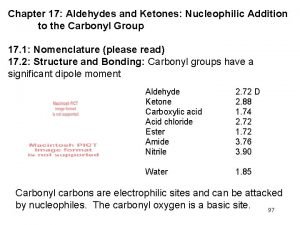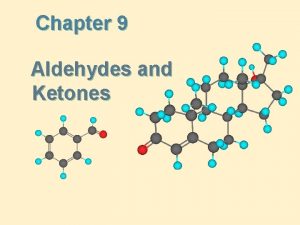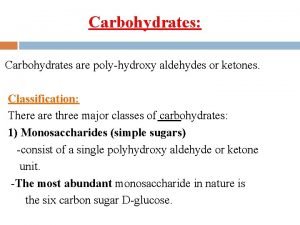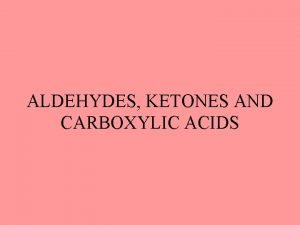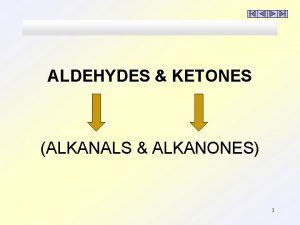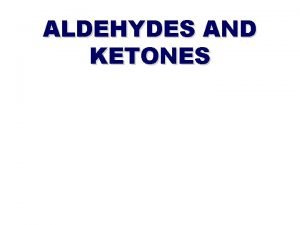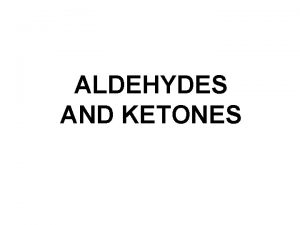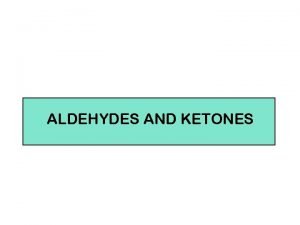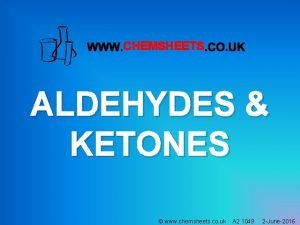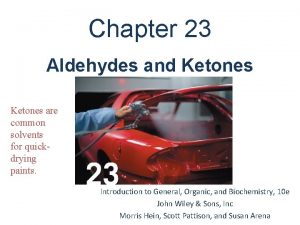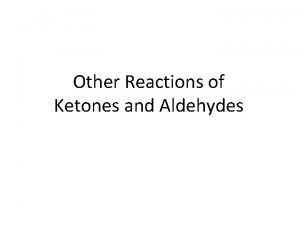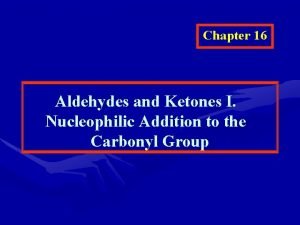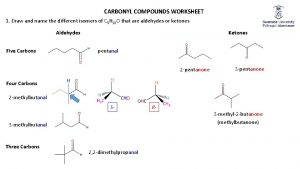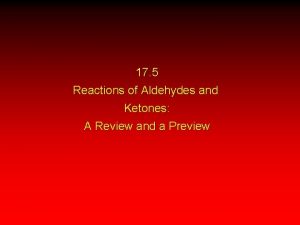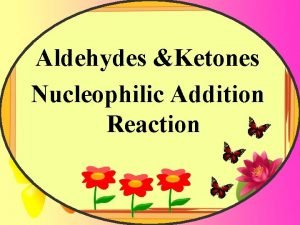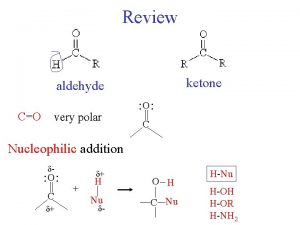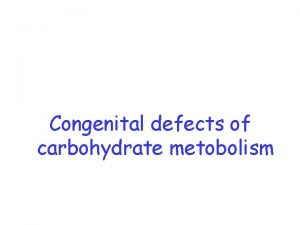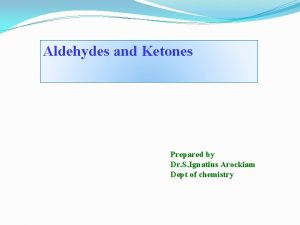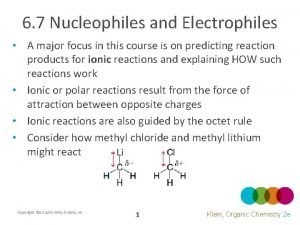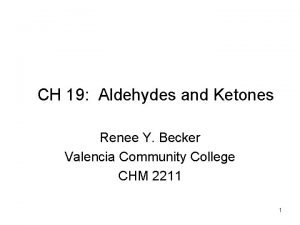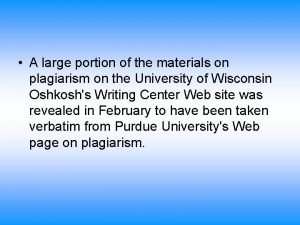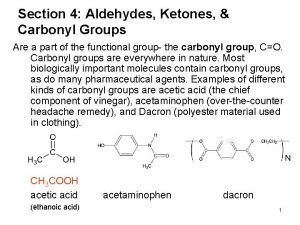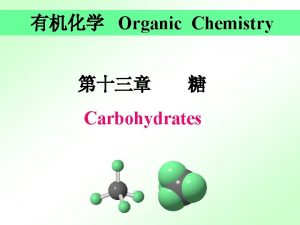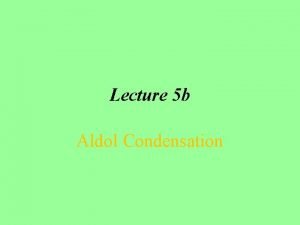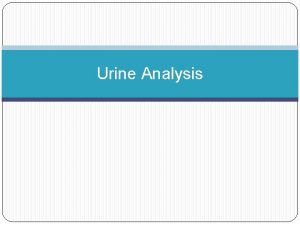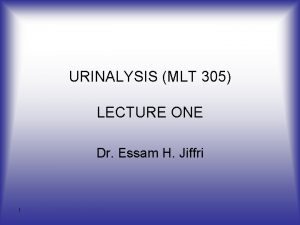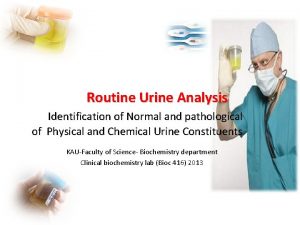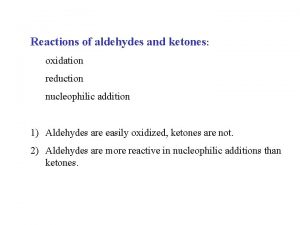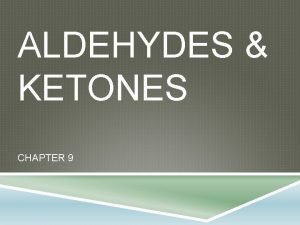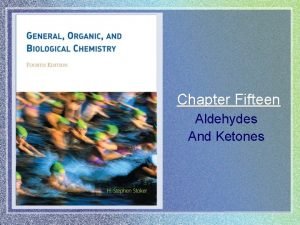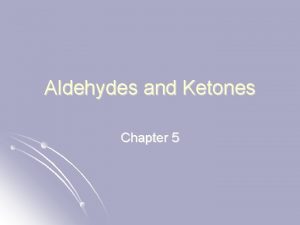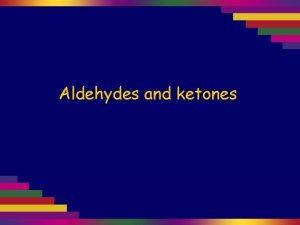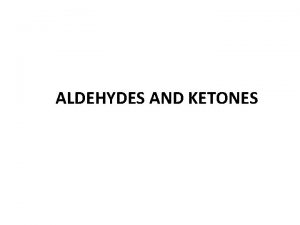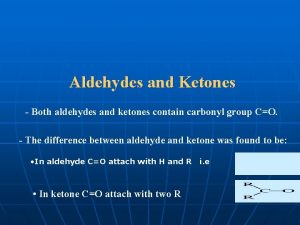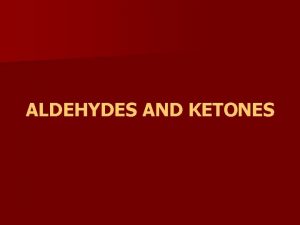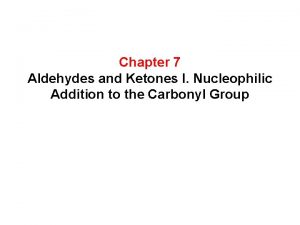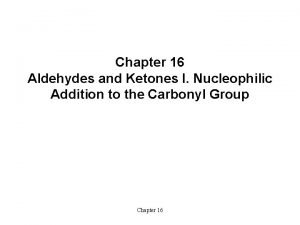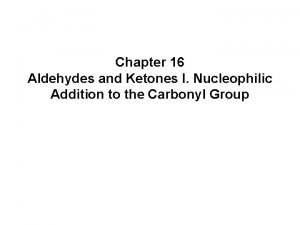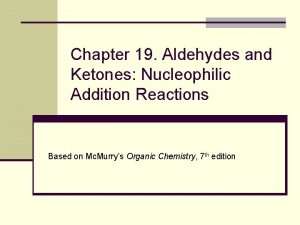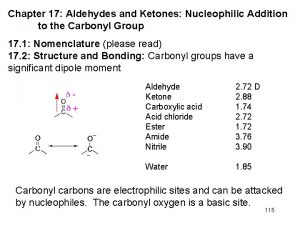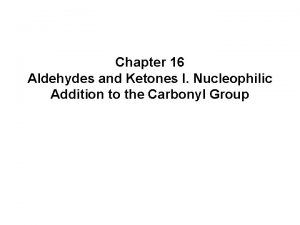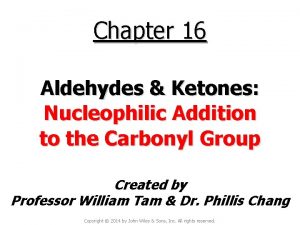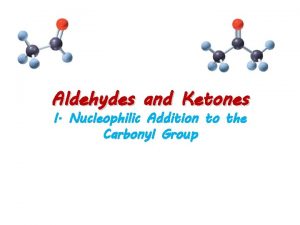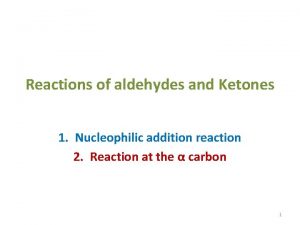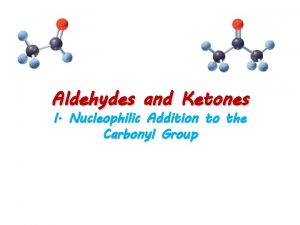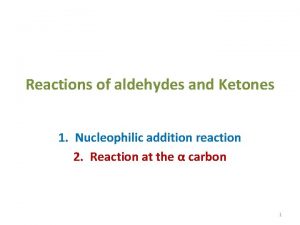Chapter 17 Aldehydes and Ketones Nucleophilic Addition to





























- Slides: 29

Chapter 17: Aldehydes and Ketones: Nucleophilic Addition to the Carbonyl Group 17. 1: Nomenclature (please read) 17. 2: Structure and Bonding: Carbonyl groups have a significant dipole moment Aldehyde Ketone Carboxylic acid Acid chloride Ester Amide Nitrile 2. 72 D 2. 88 1. 74 2. 72 1. 72 3. 76 3. 90 Water 1. 85 Carbonyl carbons are electrophilic sites and can be attacked by nucleophiles. The carbonyl oxygen is a basic site. 97

17. 3: Physical Properties (please read) 17. 4: Sources of Aldehydes and Ketones (Table 17. 1, p. 708) 1 a. Oxidation of 1° and 2° alcohols (15. 10) 1 b. From carboxylic acids 1 c. Ketones from aldehydes 98

2. Ozonolysis of alkenes (6. 20) 3. Hydration of alkynes (9. 12) 4. Friedel-Craft Acylation (12. 7) - aryl ketones 3. 5. Hydroformylation of alkenes (please read) 99

17. 5: Reactions of Aldehydes and Ketones: A Review and a Preview Reactions of aldehydes and ketones: Review: 1. Reduction to hydrocarbons a. Clemmenson reduction (Zn-Hg, HCl) b. Wolff-Kishner (H 2 NNH 2, KOH, ) 100

2. Reduction to 1° and 2° alcohols (15. 2) 3. Addition of Grignard Reagents (14. 6 -14. 7) 101

17. 6: Principles of Nucleophilic Addition: Hydration of Aldehydes and Ketones Water can reversibly add to the carbonyl carbon of aldehydes and ketones to give 1, 1 -diols (geminal or gem-diols) R= H, H R= CH 3, H R= (H 3 C)3 C, H R= CH 3, CH 3 R= CF 3, CF 3 99. 9 % hydrate 50 % 17 % 0. 14 % > 99 % The hydration reaction is base and acid catalyzed Base-catalyzed mechanism (Fig. 17. 1): hydroxide is a better nucleophile than water 102

Acid-catalyzed mechanism (Fig. 17. 2): protonated carbonyl is a better electrophile The hydration is reversible Does adding acid or base change the amount of hydrate? Does a catalysts affect Go, G‡, both, or neither 103

17. 7: Cyanohydrin Formation Addition of H-CN adds to the aldehydes and unhindered ketones. (related to the hydration reaction) The equilibrium favors cyanohydrin formation Mechanism of cyanohydron fromation (Fig. 17. 3) 104

17. 8: Acetal Formation Acetals are geminal diethers- structurally related to hydrates, which are geminal diols. hydrate (gem-diol) aldehyde hemi-acetal ketone hemi-ketal acetal (gem-diether) ketal (gem-diether) 105

Mechanism of acetal (ketal) formation is acid-catalyzed (Fig 17. 4) Dean-Stark Trap The mechanism for acetal/ketal formation is reversible How is the direction of the reaction controlled? 106

Dioxolanes and dioxanes: cyclic acetal (ketals) from 1, 2 - and 1, 3 -diols 1, 3 -dioxolane 1, 2 -diol 1, 3 -dioxane 1, 3 -diol 107

17. 9: Acetals (Ketals) as Protecting Groups Protecting group: Temporarily convert a functional group that is incompatible with a set of reaction conditions into a new functional group (with the protecting group) that is compatible with the reaction. The protecting group is then removed giving the original functional group (deprotection). 108

The reaction cannot be done directly, as shown. Why? 17. 10: Reaction with Primary Amines: Imines (Schiff base) Aldehyde or ketone hemi-acetal or hemi-ketal Aldehyde or ketone carbinolamine imine acetal or ketal 109

Mechanism of imine formation (Fig. 17. 5): See Table 17. 4 for the related carbonyl derivative, oximes, hydrazone and semicarbazides (please read) 110

17. 11: Reaction with Secondary Amines: Enamines 1° amine: Imine 2° amine: Iminium ion ketone with -protons iminium ion enamine Mechanism of enamine formation (Fig 17. 6) 111

17. 12: The Wittig Reaction 1979 Nobel Prize in Chemistry: Georg Wittig (Wittig Reaction) and H. C. Brown (Hydroboration) The synthesis of an alkene from the reaction of an aldehyde or ketone and a phosphorus ylide (Wittig reagent), a dipolar intermediate with formal opposite charges on adjacent atoms (overall charge neutral). aldehyde or ketone triphenylphosphonium ylide (Wittig reagent) alkene triphenylphosphine oxide Accepted mechanism (Fig. 17. 7) (please read) 112

The Wittig reaction gives C=C in a defined location, based on the location of the carbonyl group (C=O) The Wittig reaction is highly selective for ketones and aldehydes; esters, lactones, nitriles and amides will not react but are tolerated in the substrate. Acidic groups (alcohols, amine and carboxylic acids) are not tolerated. Predicting the geometry (E/Z) of the alkene product is complex and is dependent upon the nature of the ylide. 113

17. 13: Planning an Alkene Synthesis via the Wittig Reaction A Wittig reagent is prepared from the reaction of an alkyl halide with triphenylphosphine (Ph 3 P: ) to give a phosphonium salt. The protons on the carbon adjacent to phosphorous are acidic. Deprotonation of the phosphonium salt with a strong base gives the ylide. A phosphorane is a neutral resonance structure of the ylide. 114

• There will be two possible Wittig routes to an alkene. • Analyze the structure retrosynthetically, i. e. , work the synthesis out backworks • Disconnect (break the bond of the target that can be formed by a known reaction) the doubly bonded carbons. One becomes the aldehyde or ketone, the other the ylide 115

17. 14: Stereoselective Addition to Carbonyl Groups (please read) 17. 15: Oxidation of Aldehydes Increasing oxidation state 116

Aldehydes are oxidized by Cr(VI) reagents to carboxylic acids in aqueous acid. The reactions proceeds through the hydrate 117

17. 16: Baeyer-Villiger Oxidation of Ketones. Oxidation of ketones with a peroxy acid (m. CPBA) to give as esters Oxygen insertion occurs between carbonyl carbon and more the substituted -carbon 118

19. 17: Spectroscopic Analysis of Aldehydes and Ketones Infrared Spectroscopy: highly diagnostic for carbonyl groups Carbonyls have a strong C=O absorption peak between 1660 - 1770 cm 1 Aldehydes also have two characteristic C–H absorptions around 2720 - 2820 cm 1 Butanal C-H 2720, 2815 cm-1 C=O (1730 cm-1) 2 -Butanone C-H C=O (1720 cm-1) 119

C=O stretches of aliphatic, conjugated, aryl and cyclic carbonyls: Conjugation moves the C=O stretch to lower energy (right, lower cm-1) Ring (angle) strain moves the C=O stretch to higher energy 120 (left, higher cm-1)

1 H NMR Spectra of Aldehydes and Ketones: The 1 H chemical shift range for the aldehyde proton is 9 -10 ppm The aldehyde proton will couple to the protons on the -carbon with a typical coupling constant of J 2 Hz A carbonyl will slightly deshield the protons on the -carbon; typical chemical shift range is 2. 0 - 2. 5 ppm = 2. 4, dt, J= 1. 8, 7. 0, 2 H = 1. 65, sextet, J= 7. 0, 2 H = 1. 65, t, J= 7. 0, 3 H = 9. 8, t, J= 1. 8, 1 H 121

= 2. 5 (2 H, q, J = 7. 3) 2. 1 (3 H, s) 1. 1 (3 H, t, J = 7. 3) 7. 0 -6. 0 = 6. 8 (1 H, dq, J =15, 7. 0) 6. 1 (1 H, d, J = 15) 2. 6 (2 H, q, J = 7. 4) 1. 9 (3 H, d, J = 7. 0 ) 1. 1 (3 H, t, J = 7. 4) 2. 7 - 1. 0 122

13 C NMR: The intensity of the carbonyl resonance in the 13 C spectrum usually weak and sometimes not observed. The chemical shift range is diagnostic for the type of carbonyl ketones & aldehydes: carboxylic acids, esters, and amides = ~ 190 - 220 ppm = ~ 165 - 185 ppm = 220, 38, 23 = 174, 60, 27, 14, 9 carbonyl CDCl 3 123

C 9 H 10 O 2 IR: 1695 cm-1 13 C NMR: 191 163 130 128 115 65 15 1 H s 2 H d, J= 8. 5 2 H q, J= 7. 5 3 H (t, J= 7. 5) C 10 H 12 O IR: 1710 cm-1 13 C NMR: 207 134 130 128 126 52 37 10 2 H (q, J= 7. 3) 3 H (t, J= 7. 3) 2 H 5 H 124

C 9 H 10 O 9. 8 (1 H, t, J =1. 5) 7. 3 (2 H, m) 9. 7 - 9. 9 7. 2 (3 H, m) 2. 9 (2 H, t, J = 7. 7) 7. 0 - 7. 8 2. 7 (2 H, dt, J = 7. 7, 1. 5) 3. 1 - 2. 5 129, 128, 125 28 45 201 140 CDCl 3 125
 Aldehydes and ketones nucleophilic addition
Aldehydes and ketones nucleophilic addition Aldehydes and ketones structure
Aldehydes and ketones structure Polyhydroxy aldehyde
Polyhydroxy aldehyde Aldehydes to carboxylic acids
Aldehydes to carboxylic acids Nomenclature of aldehydes examples
Nomenclature of aldehydes examples Aldehyde and ketone solubility in water
Aldehyde and ketone solubility in water Carbonyl group aldehyde and ketone
Carbonyl group aldehyde and ketone Carbonyl vs ketone
Carbonyl vs ketone Chemsheets
Chemsheets Chemical properties of ketones
Chemical properties of ketones Ketone reactivity
Ketone reactivity Reactions of aldehydes and ketones summary
Reactions of aldehydes and ketones summary Naming aldehydes and ketones worksheet with answers doc
Naming aldehydes and ketones worksheet with answers doc Cyanohydrin formation
Cyanohydrin formation Nucleophilic addition
Nucleophilic addition Nucleophilic addition
Nucleophilic addition Galactosemia mechanism
Galactosemia mechanism Aldehyde and ketones
Aldehyde and ketones Arrow pushing patterns
Arrow pushing patterns Ether functional group examples
Ether functional group examples Uses of ketones
Uses of ketones Naming ether
Naming ether Carbonyl group
Carbonyl group Polyhydroxy aldehyde
Polyhydroxy aldehyde Aldol condensation aldehyde
Aldol condensation aldehyde Principle of fouchet's test
Principle of fouchet's test Sodium nitroprusside test for ketones
Sodium nitroprusside test for ketones Urinalysis sediment
Urinalysis sediment Oxidation of ketones
Oxidation of ketones Properties of ketones
Properties of ketones
